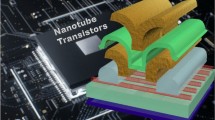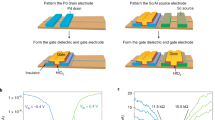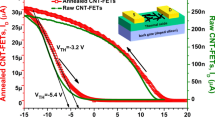Abstract
Over the last sixty years, the scaling of silicon-based complementary metal-oxide-semiconductor (CMOS) field-effect transistors (FETs) have promoted the rapid development of microelectronic technology. However, the development of Si CMOS technology is currently subject to serious challenges from various aspects such as physics limit, cost, and power consumption, and is becoming increasingly difficult. Material innovation is exerting an ever-greater role in the integrated circuit design. By looking for thinner semiconductor materials with higher mobility as the active layer to construct smaller and higher-performance transistors, it is possible to further stimulate transistors and integrated circuits on performance, density, power dissipation, and functions. In 1991, Iijima discovered carbon nanotubes (CNTs). Due to its excellent electrical properties and intrinsic nano-scale size, CNT has been considered by academia and industry to have great potential to replace silicon materials in the future for the extremely scaled technology nodes or novel electronic applications. This paper reviews the latest advancements in CNT-based electronics research. Finally, the challenges and pathways for nanotube transistors to transition into commercial applications are discussed.
Similar content being viewed by others
References
Kilby J S C. Turning potential into realities: the invention of the integrated circuit (Nobel lecture). ChemPhysChem, 2001, 2: 482–489
Bardeen J, Brattain W H. The transistor, a semi-conductor triode. Phys Rev, 1948, 74: 230–231
Cavin R K, Lugli P, Zhirnov V V. Science and engineering beyond Moore’s law. Proc IEEE, 2012, 100: 1720–1749
Waldrop M M. The chips are down for Moore’s law. Nature, 2016, 530: 144–147
Avouris P, Chen J. Nanotube electronics and optoelectronics. Mater Today, 2006, 9: 46–54
Rutherglen C, Jain D, Burke P. Nanotube electronics for radiofrequency applications. Nat Nanotech, 2009, 4: 811–819
Peng L M, Zhang Z Y, Wang S. Carbon nanotube electronics: recent advances. Mater Today, 2014, 17: 433–442
Chen Z H, Wong H S P, Mitra S, et al. Carbon nanotubes for high-performance logic. MRS Bull, 2014, 39: 719–726
Sun J Y C. System scaling for intelligent ubiquitous computing. In: Proceedings of IEEE International Electron Devices Meeting (IEDM), 2017. 1–7
Franklin A D. Nanomaterials in transistors: from high-performance to thin-film applications. Science, 2015, 349: aab2750
Zhang H, Xiang L, Yang Y, et al. High-performance carbon nanotube complementary electronics and integrated sensor systems on ultrathin plastic foil. ACS Nano, 2018, 12: 2773–2779
Xiang L, Zhang H, Dong G, et al. Low-power carbon nanotube-based integrated circuits that can be transferred to biological surfaces. Nat Electron, 2018, 1: 237–245
Xiang L, Xia F, Zhang H, et al. Wafer-scale high-yield manufacturing of degradable electronics for environmental monitoring. Adv Funct Mater, 2019, 29: 1905518
Cao Q, Kim H, Pimparkar N, et al. Medium-scale carbon nanotube thin-film integrated circuits on flexible plastic substrates. Nature, 2008, 454: 495–500
Sun Y, Wang B W, Hou P X, et al. A carbon nanotube non-volatile memory device using a photoresist gate dielectric. Carbon, 2017, 124: 700–707
Qu T Y, Sun Y, Chen M L, et al. A flexible carbon nanotube sen-memory device. Adv Mater, 2020, 32: 1907288
Yu W J, Chae S H, Lee S Y, et al. Ultra-transparent, flexible single-walled carbon nanotube non-volatile memory device with an oxygen-decorated graphene electrode. Adv Mater, 2011, 23: 1889–1893
Louarn A L, Kapche F, Bethoux J M, et al. Intrinsic current gain cutoff frequency of 30 GHz with carbon nanotube transistors. Appl Phys Lett, 2007, 90: 233108
Bethoux J M, Happy H, Dambrine G, et al. An 8-GHz f/sub t/carbon nanotube field-effect transistor for gigahertz range applications. IEEE Electron Device Lett, 2006, 27: 681–683
Chen Y Y, Sun Y, Zhu Q B, et al. High-throughput fabrication of flexible and transparent all-carbon nanotube electronics. Adv Sci, 2018, 5: 1700965
Yamada T, Hayamizu Y, Yamamoto Y, et al. A stretchable carbon nanotube strain sensor for human-motion detection. Nat Nanotech, 2011, 6: 296–301
Ryu S, Lee P, Chou J B, et al. Extremely elastic wearable carbon nanotube fiber strain sensor for monitoring of human motion. ACS Nano, 2015, 9: 5929–5936
Iijima S. Helical microtubules of graphitic carbon. Nature, 1991, 354: 56–58
Chau R, Datta S, Doczy M, et al. Benchmarking nanotechnology for high-performance and low-power logic transistor applications. IEEE Trans Nanotechnol, 2005, 4: 153–158
Zhou X J, Park J Y, Huang S M, et al. Band structure, phonon scattering, and the performance limit of single-walled carbon nanotube transistors. Phys Rev Lett, 2005, 95: 146805
Perebeinos V, Tersoff J, Avouris P. Electron-phonon interaction and transport in semiconducting carbon nanotubes. Phys Rev Lett, 2005, 94: 086802
Purewal M S, Hong B H, Ravi A, et al. Scaling of resistance and electron mean free path of single-walled carbon nanotubes. Phys Rev Lett, 2007, 98: 186808
Perebeinos V, Rotkin S V, Petrov A G, et al. The effects of substrate phonon mode scattering on transport in carbon nanotubes. Nano Lett, 2009, 9: 312–316
Park J Y, Rosenblatt S, Yaish Y, et al. Electron-phonon scattering in metallic single-walled carbon nanotubes. Nano Lett, 2004, 4: 517–520
Tulevski G S, Franklin A D, Frank D, et al. Toward high-performance digital logic technology with carbon nanotubes. ACS Nano, 2014, 8: 8730–8745
Cao Q. Carbon nanotube transistor technology for More-Moore scaling. Nano Res, 2021. doi: https://doi.org/10.1007/s12274-021-3459-z
Peng L M, Zhang Z, Qiu C. Carbon nanotube digital electronics. Nat Electron, 2019, 2: 499–505
Tans S J, Verschueren A R M, Dekker C. Room-temperature transistor based on a single carbon nanotube. Nature, 1998, 393: 49–52
Martel R, Schmidt T, Shea H R, et al. Single- and multi-wall carbon nanotube field-effect transistors. Appl Phys Lett, 1998, 73: 2447–2449
Zhang Z, Liang X, Wang S, et al. Doping-free fabrication of carbon nanotube based ballistic CMOS devices and circuits. Nano Lett, 2007, 7: 3603–3607
Zhang Z, Wang S, Wang Z, et al. Almost perfectly symmetric SWCNT-based CMOS devices and scaling. ACS Nano, 2009, 3: 3781–3787
Qiu C, Zhang Z, Xiao M, et al. Scaling carbon nanotube complementary transistors to 5-nm gate lengths. Science, 2017, 355: 271–276
Zhang P, Qiu C, Zhang Z, et al. Performance projections for ballistic carbon nanotube FinFET at circuit level. Nano Res, 2016, 9: 1785–1794
Natarajan S, Agostinelli M, Akbar S, et al. A 14 nm logic technology featuring 2nd-generation FinFET, air-gapped interconnects, self-aligned double patterning and a 0.0588 µm 2 SRAM cell size. In: Proceedings of IEEE International Electron Devices Meeting (IEDM), 2014. 1–3
Franklin A D, Chen Z. Length scaling of carbon nanotube transistors. Nat Nanotech, 2010, 5: 858–862
Qiu C, Liu F, Xu L, et al. Dirac-source field-effect transistors as energy-efficient, high-performance electronic switches. Science, 2018, 361: 387–392
Aly M M S, Gao M, Hills G, et al. Energy-efficient abundant-data computing: the N3XT 1,000x. Computer, 2015, 48: 24–33
Shulaker M M, Hills G, Park R S, et al. Three-dimensional integration of nanotechnologies for computing and data storage on a single chip. Nature, 2017, 547: 74–78
Fleetwood D M. Evolution of total ionizing dose effects in MOS devices with Moore’s law scaling. IEEE Trans Nucl Sci, 2018, 65: 1465–1481
Barnaby H J. Total-ionizing-dose effects in modern CMOS technologies. IEEE Trans Nucl Sci, 2006, 53: 3103–3121
Zhu M, Xiao H, Yan G, et al. Radiation-hardened and repairable integrated circuits based on carbon nanotube transistors with ion gel gates. Nat Electron, 2020, 3: 622–629
Flament O, Torres A, Ferlet-Cavrois V. Bias dependence of FD transistor response to total dose irradiation. IEEE Trans Nucl Sci, 2003, 50: 2316–2321
Ding L, Liang S, Pei T, et al. Carbon nanotube based ultra-low voltage integrated circuits: scaling down to 0.4 V. Appl Phys Lett, 2012, 100: 263116
Nikonov D E, Young I A. Uniform methodology for benchmarking beyond-CMOS logic devices. In: Proceedings of International Electron Devices Meeting, 2012. 1–4
Gonzalez R, Horowitz M. Energy dissipation in general purpose microprocessors. IEEE J Solid-State Circ, 1996, 31: 1277–1284
Hills G, Bardon M G, Doornbos G, et al. Understanding energy efficiency benefits of carbon nanotube field-effect transistors for digital VLSI. IEEE Trans Nanotechnol, 2018, 17: 1259–1269
Chen B, Zhang P, Ding L, et al. Highly uniform carbon nanotube field-effect transistors and medium scale integrated circuits. Nano Lett, 2016, 16: 5120–5128
Yang Y, Ding L, Han J, et al. High-performance complementary transistors and medium-scale integrated circuits based on carbon nanotube thin films. ACS Nano, 2017, 11: 4124–4132
Zhong D, Zhang Z, Ding L, et al. Gigahertz integrated circuits based on carbon nanotube films. Nat Electron, 2018, 1: 40–45
Yang S, Ahmed S, Arcot B, et al. A high performance 180 nm generation logic technology. In: Proceedings of IEEE International Electron Devices Meeting (IEDM), 1998. 197–200
Shulaker M M, Hills G, Patil N, et al. Carbon nanotube computer. Nature, 2013, 501: 526–530
Hills G, Lau C, Wright A, et al. Modern microprocessor built from complementary carbon nanotube transistors. Nature, 2019, 572: 595–602
Guo J, Hasan S, Javey A, et al. Assessment of high-frequency performance potential of carbon nanotube transistors. IEEE Trans Nanotechnol, 2005, 4: 715–721
Wang C, Badmaev A, Jooyaie A, et al. Radio frequency and linearity performance of transistors using high-purity semiconducting carbon nanotubes. ACS Nano, 2011, 5: 4169–4176
Zhong D, Shi H, Ding L, et al. Carbon nanotube film-based radio frequency transistors with maximum oscillation frequency above 100 GHz. ACS Appl Mater Interfaces, 2019, 11: 42496–42503
Liu L, Ding L, Zhong D, et al. Carbon nanotube complementary gigahertz integrated circuits and their applications on wireless sensor interface systems. ACS Nano, 2019, 13: 2526–2535
Liang Y, Xiao M, Wu D, et al. Wafer-scale uniform carbon nanotube transistors for ultrasensitive and label-free detection of disease biomarkers. ACS Nano, 2020, 14: 8866–8874
Xiao M, Liang S, Han J, et al. Batch fabrication of ultrasensitive carbon nanotube hydrogen sensors with sub-ppm detection limit. ACS Sens, 2018, 3: 749–756
Hu Y, Kang L, Zhao Q, et al. Growth of high-density horizontally aligned SWNT arrays using Trojan catalysts. Nat Commun, 2015, 6: 6099
Si J, Zhong D, Xu H, et al. Scalable preparation of high-density semiconducting carbon nanotube arrays for high-performance field-effect transistors. ACS Nano, 2018, 12: 627–634
Qiu S, Wu K, Gao B, et al. Solution-processing of high-purity semiconducting single-walled carbon nanotubes for electronics devices. Adv Mater, 2019, 31: 1800750
Brady G J, Way A J, Safron N S, et al. Quasi-ballistic carbon nanotube array transistors with current density exceeding Si and GaAs. Sci Adv, 2016, 2: e1601240
Léonard F. Crosstalk between nanotube devices: contact and channel effects. Nanotechnology, 2006, 17: 2381–2385
Cao Q, Han S, Tulevski G S, et al. Arrays of single-walled carbon nanotubes with full surface coverage for high-performance electronics. Nat Nanotech, 2013, 8: 180–186
He X, Gao W, Xie L, et al. Wafer-scale monodomain films of spontaneously aligned single-walled carbon nanotubes. Nat Nanotech, 2016, 11: 633–638
Liu L, Han J, Xu L, et al. Aligned, high-density semiconducting carbon nanotube arrays for high-performance electronics. Science, 2020, 368: 850–856
Radosavljević M, Heinze S, Tersoff J, et al. Drain voltage scaling in carbon nanotube transistors. Appl Phys Lett, 2003, 83: 2435–2437
Liu L, Zhao C, Ding L, et al. Drain-engineered carbon-nanotube-film field-effect transistors with high performance and ultra-low current leakage. Nano Res, 2020, 13: 1875–1881
Zhao C, Zhong D, Liu L, et al. Strengthened complementary metal-oxide-semiconductor logic for small-band-gap semiconductor-based high-performance and low-power application. ACS Nano, 2020, 14: 15267–15275
Subramanian S, Hosseini M, et al. First monolithic integration of 3D complementary FET (CFET) on 300 mm wafers. In: Proceedings of IEEE Symposium on VLSI Technology, 2020. 20210682
Shulaker M M, Wu T F, Pal A, et al. Monolithic 3D integration of logic and memory: carbon nanotube FETs, resistive RAM, and silicon FETs. In: Proceedings of IEEE International Electron Devices Meeting, 2014. 14933690
Liu Y, Zhang J, Peng L M. Three-dimensional integration of plasmonics and nanoelectronics. Nat Electron, 2018, 1: 644–651
Chang S W, Sung P J, Chu T Y, et al. First demonstration of CMOS inverter and 6T-SRAM based on GAA CFETs structure for 3D-IC applications. In: Proceedings of IEEE International Electron Devices Meeting (IEDM), 2019. 19359374
Zhao Y, Li Q, Xiao X, et al. Three-dimensional flexible complementary metal-oxide-semiconductor logic circuits based on two-layer stacks of single-walled carbon nanotube networks. ACS Nano, 2016, 10: 2193–2202
Wu T F, Li H, Huang P C, et al. Hyperdimensional computing exploiting carbon nanotube FETs, resistive RAM, and their monolithic 3D integration. IEEE J Solid-State Circ, 2018, 53: 3183–3196
Honda W, Harada S, Ishida S, et al. High-performance, mechanically flexible, and vertically integrated 3D carbon nanotube and InGaZnO complementary circuits with a temperature sensor. Adv Mater, 2015, 27: 4674–4680
Xie Y N, Zhong D L, Fan C W, et al. Highly temperature-stable carbon nanotube transistors and gighertz integrated circuits for cryogenic electronics. Adv Electron Mater, 2021. doi: https://doi.org/10.1002/aelm.202100202
Cao Q, Han S J, Tulevski G S, et al. Evaluation of field-effect mobility and contact resistance of transistors that use solution-processed single-walled carbon nanotubes. ACS Nano, 2012, 6: 6471–6477
Noyce S G, Doherty J L, Cheng Z, et al. Electronic stability of carbon nanotube transistors under long-term bias stress. Nano Lett, 2019, 19: 1460–1466
Liang S, Zhang Z, Pei T, et al. Reliability tests and improvements for Sc-contacted N-type carbon nanotube transistors. Nano Res, 2013, 6: 535–545
Acknowledgements
This work was supported by National Key Research & Development Program (Grant No. 2016YFA0201901) and Beijing Municipal Science and Technology Commission (Grant No. Z181100004418011).
Author information
Authors and Affiliations
Corresponding author
Rights and permissions
About this article
Cite this article
Xie, Y., Zhang, Z. Carbon nanotube-based CMOS transistors and integrated circuits. Sci. China Inf. Sci. 64, 201402 (2021). https://doi.org/10.1007/s11432-021-3271-8
Received:
Revised:
Accepted:
Published:
DOI: https://doi.org/10.1007/s11432-021-3271-8




